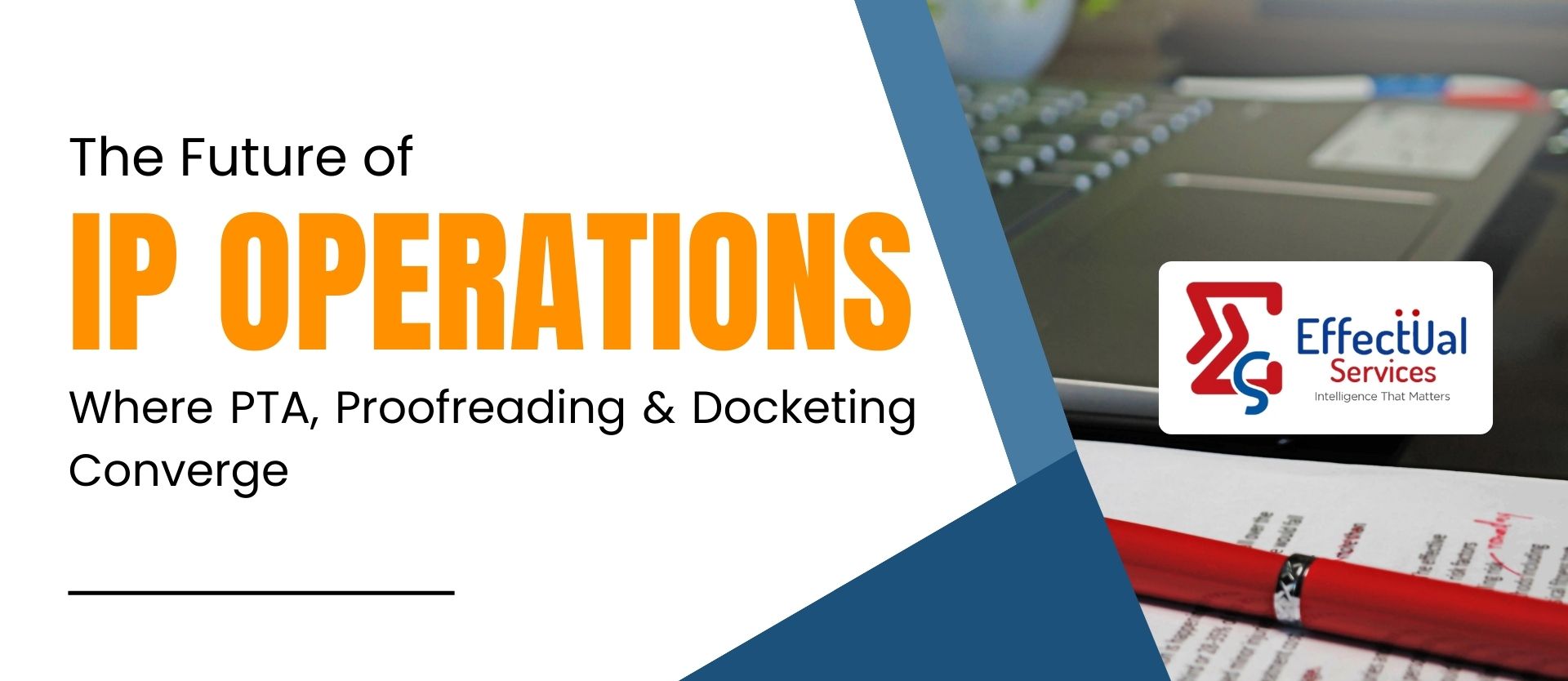The Future of IP Operations: Where PTA, Proofreading, and Docketing Converge

As the field of intellectual property (IP) continues to evolve, effective strategies for proofreading and docketing are no longer optional, they are essential for business success. Companies must protect their inventions while also staying agile in a landscape being reshaped by automation, global market changes, and emerging technologies like artificial intelligence (AI) and block-chain.
Central to its evolution is the roadmap of three pillars in IP management: Patent Term Adjustment (PTA), proofreading, and docketing. This alignment shows a new area in IP operations, described by smarter integration, greater efficiency, and continuous innovation.
Why Proofreading IP Operations Matters More Than Ever
In an innovation cycles are shorter and competition is fiercer, the ability to anticipate and adapt to changes in IP operations is critical. Most of the organization that does not evolve may be left exposed to breaches, regulatory rules, or loosed opportunities for monetization. In future IP strategies, proofreading will need to be regarded as more than a reactive measure to trends; instead, it must be reimagined proactively in the term intellectual property is managed at every stage. The integration of new technologies will be required, workflow efficiency will need to be reassessed, and core operations such as PTA, proofreading, and docketing must be ensured to function not only efficiently on their own but also effectively as a unified system.
The Convergence of PTA, Proofreading, and Docketing: A Strategic Shift
The traditionally nature of IP operations is being replaced by a more unified, strategic approach. PTA, proofreading, and docketing and once treated as separate processes are increasingly interconnected. This convergence is being driven by two major forces: technological innovation and the need for operational efficiency. The life of patent assets is maximized through the effective use of Patent Term Adjustment (PTA). Accurate PTA is calculated by navigating complex legal rules and extensive communication timelines from the USPTO. The issued patent is ensured to be free from clerical and substantive errors through thorough proofreading, so that enforceability is safeguarded and the risk of future litigation is reduced. Docketing serves as the backbone of IP workflow management, tracking deadlines, filings, and legal events with precision.
When integrated, loop of quality control, risk management, and time optimization is formed by these functions. For instance, more precise docketing protocols can be informed by errors identified during proofreading, while PTA penalties due to missed deadlines can be avoided through improved docketing practices.
The Role of Emerging Technologies in Operational Convergence
Artificial Intelligence: Enhancing IP Processes
The most essential point of IP operations is used by artificial intelligence. In the area of PTA, USPTO notices can be interpreted, adjustments calculated, and future term losses simulated by AI-powered tools. In proofreading, inconsistencies between claims and specifications can be flagged, formatting issues identified, and jurisdiction-specific compliance ensured by AI-driven algorithms.
In docketing, machine learning is being incorporated to predict filing timelines, detect anomalies, and minimize the chances of missed deadlines. Efficiency can not only be enhanced by AI, but strategic foresight is also introduced by AI with insights being provided to support better decisions across IP portfolios.
At the same time, the legal recognition and IP rights of AI-generated content are being brought into question. As more elements of IP management are automated, continuous attention must be paid to emerging laws and regulations created to address the evolving digital IP landscape.
Block chain: Ensuring Integrity and Transparency
A growing role is also being played by block chain technology in securing and optimizing IP operations. The most valuable applications are the innovation of immutable data for PTA calculations and submissions, the use of smart contacts to license agreements and payment workflows, and the provision of timesheet proofs to strengthen the authenticity of innovation disclosures and patents filings.
In docketing, tamper-proof audit can be made through the use of block chain technology, allowing regulatory compliance to be ensured and trusted to be strengthened among audits or legal disputes.
Benefits of an Integrated IP Operations Model
A strong foundation for future-oriented IP strategies is provided by the convergence of PTA, proofreading, and docketing through advanced technologies. Many of the key factor benefits are seen through this integration. It needs more accuracy to improve at every stage of patent management, which helps reduce mistakes and decreased the risk of problems like PTA loss, drafting errors, or missed deadlines. Efficiency is the key pointer that increased as manual work to reduce with the help of automation and better coordination, and IP teams are able to focus more on important strategic tasks and make it more efficient. Better forecasting, budgeting, and decision-making across jurisdictions are supported by real-time data that is provided through interconnected systems.
Preparing for the Future: Recommendations for IP Teams
To take full advantage of evolving IP operations, several steps should be taken by organizations. Integrated IP platforms should be invested in, so that PTA, proofreading, and docketing can be brought together to allow smooth data flow and communication. AI and blockchain should be used carefully, with the most useful areas being chosen and the right training and rules being provided.
High-quality data should be prioritized, as the effectiveness of automation and analytics is determined by the cleanliness and accuracy of data inputs. Ongoing changes in legal frameworks must also be closely monitored, especially as laws surrounding AI-generated IP and digital records continue to develop, so that proactive compliance can be maintained.
A Culture of Continuous Innovation
Encourage cross-functional collaboration between legal, technical, and administrative teams to keep refining and future-proofing IP workflows.
The landscape of Intellectual Property (IP) operations is undergoing rapid transformation. As technology evolves and patent portfolios become more complex, the convergence of key operational tasks Patent Term Adjustment (PTA) management, proofreading, and docketing is becoming critical. It is not just about efficiency and it also talk about productivity; it's about creating a smarter, more connected IP ecosystem that less risk, enhances accuracy, and supports strategic decision-making.
The complexity of IP operations today is reflected in the wide range of responsibilities that must be addressed by IP teams. Filing deadlines are tracked, global patent portfolios are managed, patent claims are checked for accuracy, and Patent Term Adjustments are calculated to make sure the full value of a patent is protected. These tasks have usually been done separately, using different tools or outside service providers. This scattered way of working has been linked to missed deadlines, patent mistakes, and financial or strategic problems. Over time, these problems have become worse. The systems used for docketing, proofreading, and PTA are often not connected, which causes delays and incorrect or mismatched data.
Constant changes in legal regulations across different countries require IP teams to remain continuously updated and well-informed. The management of large volumes of documents and strict deadlines across extensive portfolios is handled under increasing pressure, raising the likelihood of errors.
In the absence of system integration, the maintenance of a real-time and accurate view of portfolio performance is made difficult.
PTA: A Strategic Asset, Not Just a Formality
Patent Term Adjustment is designed to compensate for time lost due to USPTO delays, ensuring that inventors are granted the full protection period to which they are entitled. However, when PTA is miscalculated, protection periods may be shortened, and potential legal complications can be introduced.
Companies are starting to explore PTA as a valuable strategic tool not just a routine compliance task. This is especially true in fields like biotech and pharmaceuticals, where even a few extra days of patent life can make a big financial difference.
Proofreading: Shifting from Reactive to Preventive
Proofreading used to be mostly about catching typos and small errors after a patent was granted. But today’s tools, many powered by AI, go much further. They can catch deeper problems like inconsistent claims or missing references before those issues become expensive to fix. When proofreading is done early in the process during drafting, prosecution, and right after the patent is granted it helps create stronger, cleaner patents. This proactive approach reduces the need for corrections later on and ensures better legal protection from the start.
Docketing: The Nervous System of IP Ops
Docketing is no longer just a date-tracking system; it’s the central nervous system that coordinates deadlines, workflows, and alerts across global teams. With docketing platforms integrating AI and rule-based engines, they now serve as strategic platforms to unify disparate IP tasks.
The Convergence: One System, Multiple Functions
Imagine a future (that is rapidly becoming present) where:
- A PTA calculator integrates directly into the docketing platform and updates automatically based on USPTO status updates.
- Proofreading software flags issues as soon as the claims are uploaded, syncing with the docket to schedule revisions or corrections.
- Docketing entries auto-populate based on proofreading or PTA findings, triggering alerts for legal review or client updates.
This convergence ensures:
- Higher Accuracy: Reduced human error from duplicated data entry or system disconnects.
- Efficiency Gains: Tasks that once took hours now take minutes.
- Strategic Insight: Integrated data enables better forecasting, resource allocation, and patent valuation.
AI and Automation: Driving the Future
Machine learning is accelerating this convergence. Platforms are being trained on thousands of patent documents to spot errors, predict PTA more accurately, and even suggest docketing strategies based on USPTO trends. Natural language processing (NLP) enables automated extraction of critical metadata from office actions and decisions, feeding directly into IP management systems.
What IP Teams Should Do Now
- Invest in integrated platforms: Choose tools that offer native interoperability across proofreading, docketing, and PTA.
- Eliminate silos: Ensure legal ops, attorneys, and paralegals work off the same data sources.
- Prioritize automation: Free up skilled professionals from rote tasks to focus on strategy and risk management.
Conclusion
The future of IP operations lies in the convergence of PTA, proofreading, and docketing united through the power of AI and block chain. This shift marks a departure from siloes systems toward a holistic, strategic, and technology-driven IP management model. By embracing this transformation, organizations can reduce risk, increase efficiency, and ensure that their intellectual assets remain protected and profitable in a fast-changing world.
As IP continues to grow in complexity and value, future-ready IP strategies will be defined not just by what technologies they adopt, but by how seamlessly they integrate core operational pillars. The time to act is now where the future of IP operations is already taking shape.
The convergence of PTA, proofreading, and docketing signals a broader shift in IP operations from reactive to proactive, from manual to automated, from fragmented to unified. By embracing this future, IP teams can not only reduce errors and costs but elevate their strategic value within the organization. Organizations that embrace this transformation will be better positioned to future-proof their IP strategies, reduce operational risk, and maximize the value of their intellectual assets. In a world where the pace of innovation continues to accelerate, the convergence of IP operations marks a decisive step toward smarter, more resilient IP management.
Solutions Driving Innovation & Intelligence
Enabling Fortune 500's, R&D Giants, Law firms, Universities, Research institutes & SME's Around The Globe Gather Intelligence That
Protects and Nurtures Innovation Through a Team of 250+ Techno Legal Professionals.

